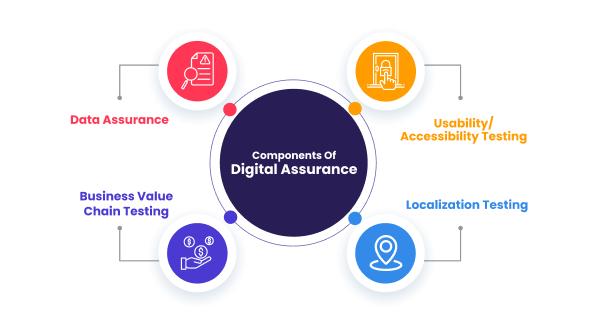Apr 21, 2023
Digital Assurance Testing: An Essential To The Future of Tech

The transition refers to a rapid increase in the number of software releases and added pressure on development teams to develop technology that delivers the ultimate end-user experience. And since user experience takes the front seat when it comes to any aspect of software development, digital assurance comes here to the rescue.
As per Forrester, the organizations implementing QA are 50 percent more likely to deliver software on time. Besides, the ever-increasing complications, use of integrated technologies, and complex systems have all added to greater complexity on SDLC. Digital Assurance allows syncing the product objectives with the scope and expected output of a technology.
Ultimately, digital assurance services come as a value practice to the entire customer chain when developers or enterprise need to meet the highest capabilities on a product intended to drive. Since BugRaptors has always underlined the need for quality engineering and digital assurance in overcoming business specific challenges, let us quickly explore digital assurance testing in detail while learning the implementation challenges and the way to success through them.Digital Assurance & Its Components
Digital assurance complements the digital transformation projects by simplifying the entire path to the achievement of end objectives. In other words, digital assurance practices are defined to drive quality to the digital transformation projects by aligning them on essential technological paradigms like cloud, mobility, etc.
Integrating digital assurance services offers significant business benefits when worked along with development and testing lifecycle. It is meant to offer streamlined workflows for improved product capability, improved user journey, and accelerated product delivery.
Also, agile and DevOps methodologies are vital for digital assurance as they complement the entire development and testing framework. Besides, the key components of the digital assurance process could be listed as:
-
Data Assurance: To work on the accuracy, completeness, and security of the data associated to app system or cloud.
-
Business Value Chain Testing: To examine the flow of business process in cloud and digital system to support users as well as business strategy.
-
Localization Testing: To test software to align with regional requirements such as cultural and linguistic goals.
-
Usability/Accessibility Testing: To ensure software made must be easy to use and accessible to all users, irrespective of any disabilities.
How Digital Assurance Testing Works?
Traditional quality assurance involved a limited set of testing procedures including functional testing, web testing, end-to-end testing, and testing of non-functional aspects that complement all the defined operations.
However, the increasing complexity in tech and the customer objectives have made organizations align with agile testing techniques.
Here comes the role of digital assurance testing in digital transformation!Digital assurance testing works by addressing the goals surrounding user experience while keeping a check on all the factors that help create a sustainable product. These include:
Globalization & Localization
Digital assurance testing aims to give equal and consistent access to any digital product or service. It involves checking on the localized and global versions of the product to ensure they work well in all geographical locations.
Omnichannel Experience
Since customers as well as business users operate across dynamic channels, creating a seamless user experience requires creating products that work well across all channels. These include apps, mobile solutions, web technology as well as improving the in-store experience using technology in order to keep users engaged.
User Experience
Since customers these days are familiar with the technology, it has become necessary to create technology that can overrule those available in the market. The digital assurance strategies are designed to offer consistent yet extraordinary customer experience.
Performance & Security
The digital assurance measures are designed to work on all the features and benchmarks of excellence. Digital assurance covers all the security vulnerabilities to ensure the product must meet highest benchmarks of quality.
Continuous Deployment
Unlike siloed testing, digital assurance allows embracing modern testing techniques like continuous deployment and continuous delivery. Ultimately, digital assurance infuses quality into a product from the earliest stages allowing users to meet business assurance goals and seek continuous deployment.
Find Out How The Entire Model Of Agile, DevOps, & Continuous Testing Works!
Download Ebook: Continuous Testing and DevOps
Cross-browser Compatibility
With digital assurance, apps are tested for the highest quality across different browsers considering all the aspects of performance superiority.
Deployment & Time-to-market
With integration of continuous testing and continuous deployment practices, the digital assurance teams could foster quality engineering at a greater pace. From use of scriptless tools to automation, digital assurance complements the entire development lifecycle.
Challenges Implementing Digital Assurance
Unlike any other business process or operation, digital assurance needs effort. Since a reliable and efficient approach requires the right understanding of hurdles on the way, here are certain challenges that you might encounter on your way to fostering digital assurance.
- Inadequate Testing Integration: One of the most significant challenges that testers working on digital assurance have to overcome is taking the right path to testing. This involves all the testing practices adopted on the basis of the selected development method.
- Data Management & Privacy: It is vital that all the privacy laws and regulations must be adhered to the increasing volume of data and development complexity. Failing to cope with data goals could directly hamper the safety of the data.
- Missing Standardization: Another challenge that testers and developers have to face with digital assurance is developing a strategy that involves the right set of standards.
- Measuring & Tracking: It is necessary that the effectiveness of the digital assurance process is measured to accurately track and assess the results relating to quality.
Digital Assurance, QA, & The Changing Landscape
When creating an application or software, it becomes vital to align with quality goals. The process usually works at improving the user experience while ensuring all the defined objectives are met within the defined time.
Therefore, it is necessary that both developers and testers are well-aware of their roles and responsibilities in defining the digital assurance benchmarks. Digital Assurance needs the right amalgamation of operations, development, and testing to ensure the applications work as intended.
All in all, quality control through digital assurance is a collaborative responsibility that needs testers to check for any flaws in the code while developers to check for the user experience. More importantly, the approach must well accommodate all the activities that could aid continuous testing, rapid deliveries, and business continuity. Thus, harnessing digital assurance could do wonders in terms of reducing the testing period for any given software while streamlining the deployment of any complex application.
Delivering high-quality software could get complicated at times. However, partnering with a digital assurance service provider like BugRaptors enables you to get necessary insights, knowledge, and support on gaining competitive advantage and meet your digital transformation goals.
For more information, reach our team at info@bugraptors.com